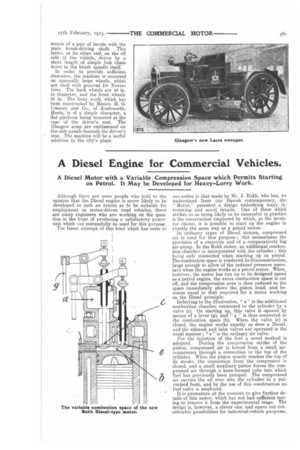A Diesel Engine for Commercial Vehicles.
Page 7

If you've noticed an error in this article please click here to report it so we can fix it.
A Diesel Motor with a Variable Compression Space which Permits Starting on Petrol. It May be Developed for Heavy-Lorry Work.
Although there are some people who hold to the opinion that the Diesel engine is never likely to be developed to such an extent as to be suitable for employment on motor-driven road vehicles, there are many engineers who are working on the question in the hope of producing a satisfactory powerunit which can succesafully be used for this purpose.
The latest attempt of this kind which has come to our notice is that made by Mr. J. Bukh, who has, we understand from our Danish contemporary, the "Motor," patented a. design embodying many interesting and novel details. One of these which strikes us as being likely to be successful in practiceis the construction employed by which, so the inventor claims, it is possible to start. up the engine in exactly the same way as a petrol motor. In ordinary types of Diesel motors, compressed air is used for this purpose ; this necessitates the provision of a reservoir and of a comparatively big air-pump. In the Bukh motor, an additional combustion chamber is incorporated with the cylinder ; this being only connected when starting up on petrol. The combustion space is rendered, by this construction, large enough to allow of the reduced pressure necessary when the engine works as a petrol motor. When, however, the motor has run up to its designed speed as a petrol engine, the extra combustion space is cut off, and the compression area is then reduced to the space immediately above the piston head, and becomes equal to that required for a motor working on the Diesel principle. Referring to the illustration, " a " is the additional combustion chamber connected to the cylinder by a valve (c). On starting up, this valve is opened by means of a lever (g), and " a " is thus connected to the combustion space (b). When the valve (c) is closed, the engine works exactly as does a Diesel, and the exhaust and inlet valves are operated in the usual manner ; " e " is the ordinary air valve. For the injection of the fuel a novel method is adopted. During the compression stroke of the piston, compressed air is forced from a small aircompressor through a connection to the top of the cylinder. When the piston nearly reaches the top of its stroke, the connection from the compressor is closed, and a small auxiliary piston forces the compressed air through a knee-formed tube into which fuel has previously been pumped. The compressed air carries the oil over into the cylinder in a pulverized form, and by the use of this construction no fuel valve is employed.
It is premature at the moment to give further details of this motor, which has not had sufficient testing.to remove it from the experimental stage. The design is, however, a clever one. and opens out eon_ siderable possibilities for industrial-vehicle purposes.


























































































